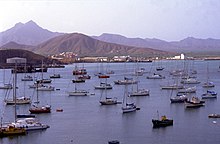Islands of Africa
The islands of Africa are a major geographical sub-region of Africa,[1][2][3][4] and represent a distinct demographic and historical cultural sphere of influence on the continent.
Introduction
The islands of Africa can be subdivided into Indian Ocean Islands and Atlantic Ocean Islands.
Geology

All of the islands of Africa, except for Madagascar, are classified as small islands under the UNESCO classification system for all islands under 2,000 square kilometres (770 sq mi).[6] Madagascar, in contrast, at 587,041 square kilometres (226,658 sq mi) is the fourth-largest island in the world. In line with most characteristics of small islands, the islands of Africa with the exception of Madagascar are almost all volcanic in origin, high in structure, with low coral elevation, with some surface water resources and undergo variable weather conditions, with occasional destructive tropical cyclones.[7]
Geography and history
Sovereign island nations
Indian Ocean islands

There are four sovereign island nations located in the Indian Ocean: Comoros, Madagascar, Mauritius and Seychelles. These countries have interrelated histories and populations over hundreds of years of interaction. These islands, in addition to the French territories of Réunion and Mayotte make up the membership of the Indian Ocean Commission.
Each of the sovereign Indian Ocean nations have complex population histories with Southeast Asian exploration and settlement, Arab trade and the Bantu migrations each playing a crucial role before later European colonization.
The
Atlantic Ocean islands

There are two sovereign island nations in the Atlantic Ocean: São Tomé and Príncipe and Cape Verde. Both islands share some historical and demographic features, especially in relation to their uses as transit points during the Atlantic slave trade.
Neither São Tomé and Príncipe nor Cape Verde were inhabited before European colonization in the wake of the Atlantic slave trade. [8][9]
European dependencies and territories
Both Spain and France retain possession of a number of territories in Africa in the form of islands in the Mediterranean Sea of the Atlantic Ocean in the case of Spain, and in the Indian Ocean in the case of France. Italy, the United Kingdom and Portugal also retain possession of small islands in the Atlantic Ocean.
The

Following the independence of
The United Kingdom also retains territories in the form of Saint Helena, Ascension, and Tristan da Cunha off Africa's western seaboard in the Atlantic Ocean, as does Portugal with the islands of Madeira north of the Canary Islands and Italy with the islands of Lampedusa and Lampione off the northern coast of Tunisia.
Other

Many continental African countries also include many islands within their territories. Some of these islands have witnessed rising secessionist movements, most notably the islands of Zanzibar in Tanzania and Lamu in Kenya. Somalia is also home to a large number of islands, including the Bajuuni Islands.
Demographics

The total population of inhabitants of the islands of Africa is estimated at a little over 30 million, with the bulk of the population of the islands of Africa residing in Madagascar.
Culture
The islands of Africa share many cultural traits due to similar settlement and population histories. Most of the
See also
References
- ^ Bowman, Larry W.; Studies, United States Dept of Education International Research and (2003-01-01). Identifying New Directions for African Studies: Data sets. p. 120.
- ^ International Journal of Communication - Issues 1-2 (2004), p. 51, books.google.com/books?id=qtwpAQAAIAAJ, 2004
- ^ African Issues. African Studies Association. 2002-01-01. p. 86.
- ^ Robert T. Watson, Marufu C. Zinyowera, Richard H. Moss, The Regional Impacts of Climate Change (1998).
- ^ M. Shahin, Hydrology and Water Resources of Africa - Volume 1 (2002), p. 565:"The islands of Africa, geographically speaking, can be subdivided into Atlantic Ocean Islands and Indian Ocean Islands. The Atlantic Ocean Islands are, in turn, subdivided into North Atlantic Islands and South Atlantic Ocean."
- ^ M. Shahin, Hydrology and Water Resources of Africa - Volume 1 (2002), p. 565:"Islands of the world, including those in Africa, can be subdivided according to their size. The surface area defining the upper limit of a small island is assumed here as 2,000 square kilometres (770 sq mi). This figure is in conformity with the classification appearing in the relevant UNESCO Reports (Falkland 1991 and 1991). According to this classification, one can easily conclude that all the islands in Africa, except Madagascar, have to be regarded as small islands."
- ^ M. Shahin, Hydrology and Water Resources of Africa - Volume 1 (2002), p. 565
- ISBN 9780875868486
- ^ Kevin Shillington, History of Africa, St. Martin's Press, Inc., 1989, p. 399
